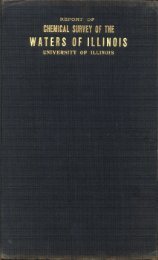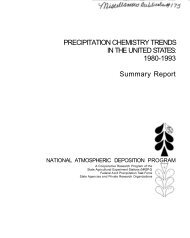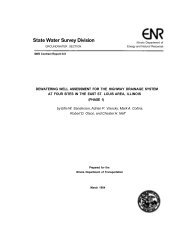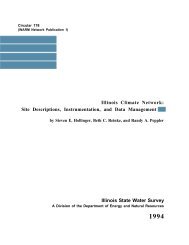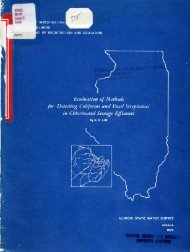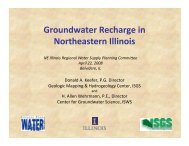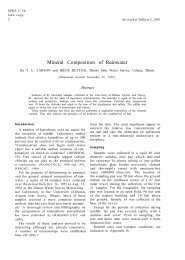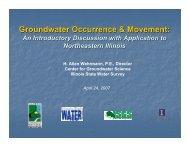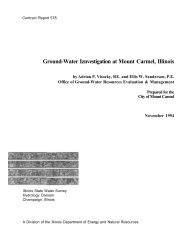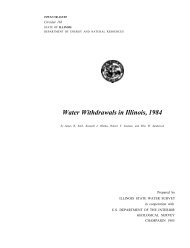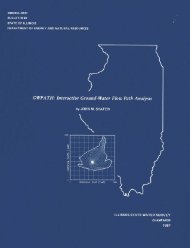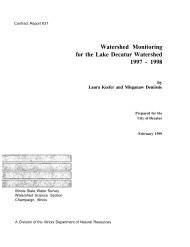Ground-water development in East St. Louis area, Illinois. Urbana, IL ...
Ground-water development in East St. Louis area, Illinois. Urbana, IL ...
Ground-water development in East St. Louis area, Illinois. Urbana, IL ...
You also want an ePaper? Increase the reach of your titles
YUMPU automatically turns print PDFs into web optimized ePapers that Google loves.
<strong>in</strong>dicate that stabilization of the piezometric surface dur<strong>in</strong>g<br />
1956 was mostly due to the effects of the Mississippi<br />
River. Dur<strong>in</strong>g much of the latter part of the drought<br />
there were long periods when little <strong>water</strong> was <strong>in</strong> the<br />
small streams and lakes <strong>in</strong> the <strong>in</strong>terior portion of the<br />
<strong>East</strong> <strong>St</strong>. <strong>Louis</strong> <strong>area</strong>, and these hydrologic features had<br />
for practical purposes negligible <strong>in</strong>fluence on <strong>water</strong> levels.<br />
Computations made with equation 4, tak<strong>in</strong>g <strong>in</strong>to consideration<br />
the Mississippi River (recharge boundary)<br />
and accumulated periods of little or no recharge directly<br />
from precipitation, <strong>in</strong>dicate that the piezometric surface<br />
for 1956 can be duplicated by us<strong>in</strong>g a time period of<br />
5 years <strong>in</strong> estimat<strong>in</strong>g <strong>water</strong>-level decl<strong>in</strong>es.<br />
Production wells were grouped <strong>in</strong>to centers of pump<strong>in</strong>g,<br />
and the average discharges dur<strong>in</strong>g the period 1952-<br />
1956 for each pump<strong>in</strong>g center were determ<strong>in</strong>ed. The analog<br />
model was coupled to the excitation-response apparatus<br />
and the pulse generator was connected to junctions<br />
at locations of pump<strong>in</strong>g centers. The output of the<br />
pulse generator was adjusted <strong>in</strong> accordance with discharge<br />
data and a maximum time period of 5 years. The oscilloscope<br />
was connected to term<strong>in</strong>als represent<strong>in</strong>g observation<br />
wells and <strong>water</strong>-level decl<strong>in</strong>es were computed. Thus,<br />
<strong>water</strong>-level decl<strong>in</strong>es everywhere <strong>in</strong> the aquifer were described.<br />
The total <strong>water</strong>-level decl<strong>in</strong>e, based on the superposition<br />
theorem, at each term<strong>in</strong>al was obta<strong>in</strong>ed by summation<br />
of <strong>in</strong>dividual effects of each pump<strong>in</strong>g center.<br />
Only the effects of pump<strong>in</strong>g centers were taken <strong>in</strong>to account<br />
and the average stage of the Mississippi River was<br />
assumed to be the same <strong>in</strong> 1956 as it was <strong>in</strong> 1900. However,<br />
records show that the average stage of the Mississippi<br />
River was about 11 feet lower <strong>in</strong> 1956 than <strong>in</strong> 1900.<br />
The effect of the change <strong>in</strong> the average stage of the<br />
river on <strong>water</strong> levels was estimated by coupl<strong>in</strong>g the,<br />
pulse generator to junctions <strong>in</strong> the analog model along<br />
the river and measur<strong>in</strong>g <strong>water</strong>-level changes due to the<br />
given change of the stage of the river with the oscilloscope<br />
connected to junctions <strong>in</strong> the <strong>in</strong>terior portions of<br />
the analog model.<br />
The above <strong>water</strong>-level decl<strong>in</strong>es due to the decl<strong>in</strong>e <strong>in</strong><br />
river stage were superposed upon <strong>water</strong>-level changes<br />
due to pumpage, and a <strong>water</strong>-level change map cover<strong>in</strong>g<br />
the period 1900 to December 1956 was prepared. A piezometric<br />
surface map (figure 61B) was constructed by<br />
superpos<strong>in</strong>g the <strong>water</strong>-level change map on the piezometric<br />
surface map for 1900.<br />
Features of the piezometric surface map prepared<br />
with data from the analog computer and the piezometric<br />
surface map prepared from actual <strong>water</strong>-level data are<br />
generally the same, as shown <strong>in</strong> figure 61. A comparison<br />
of <strong>water</strong>-level elevations for selected pump<strong>in</strong>g centers,<br />
based on the analog computer and actual piezometric<br />
surface maps, are given <strong>in</strong> table 31. The average slope of<br />
Table 31. Comparison of Analog Computer and Actual<br />
Piezometric Surface Maps for December 1956<br />
Water-level elevation<br />
(ft above msl)<br />
Pump<strong>in</strong>g<br />
center Analog computer Actual<br />
Alton <strong>area</strong> 375 375<br />
Wood River <strong>area</strong> 375 375<br />
Granite City <strong>area</strong> 345 350<br />
National City <strong>area</strong> 365 365<br />
Monsanto <strong>area</strong> 360 355<br />
Caseyville <strong>area</strong> 400 400<br />
the piezometric surface <strong>in</strong> <strong>area</strong>s remote from pump<strong>in</strong>g<br />
centers from both maps was 5 feet per mile. A comparison<br />
of gradients from analog computer and actual piezometric<br />
surface maps <strong>in</strong> the vic<strong>in</strong>ity of pump<strong>in</strong>g centers<br />
is given <strong>in</strong> table 32.<br />
Table 32. Comparison of Analog Computer and Actual<br />
Hydraulic Gradients of Piezometric Surface Maps<br />
for December 1956<br />
Average gradient (ft/mi)<br />
Pump<strong>in</strong>g<br />
center Analog computer Actual<br />
Alton <strong>area</strong> 15 15<br />
Wood River <strong>area</strong> 15 15<br />
Granite City <strong>area</strong> 20 30<br />
National City <strong>area</strong> 10 10<br />
Monsanto <strong>area</strong> 20 25<br />
Differences <strong>in</strong> analog computer and actual piezometric<br />
surface maps are not significant when considered <strong>in</strong> relation<br />
to the accuracy and adequacy of geohydrologic<br />
data. The close agreement between analog computer and<br />
actual piezometric maps <strong>in</strong>dicates that the analog computer<br />
may be used to predict with reasonable accuracy<br />
the effects of future ground-<strong>water</strong> <strong>development</strong> and the<br />
practical susta<strong>in</strong>ed yield of exist<strong>in</strong>g pump<strong>in</strong>g centers.<br />
PRACTICAL SUSTAINED YIELDS OF EXISTING PUMPING CENTERS<br />
In 1962 <strong>water</strong> levels were not at critical stages <strong>in</strong><br />
any pump<strong>in</strong>g center and there were <strong>area</strong>s of the aquifer<br />
unaffected by pump<strong>in</strong>g. Thus, the practical susta<strong>in</strong>ed<br />
yield of exist<strong>in</strong>g pump<strong>in</strong>g centers exceeds total withdrawals<br />
<strong>in</strong> 1962. The practical susta<strong>in</strong>ed yield is here de-<br />
f<strong>in</strong>ed as the rate at which ground <strong>water</strong> can be cont<strong>in</strong>uously<br />
withdrawn from wells <strong>in</strong> exist<strong>in</strong>g pump<strong>in</strong>g centers<br />
without lower<strong>in</strong>g <strong>water</strong> levels to critical stages or<br />
exceed<strong>in</strong>g recharge. <strong>Ground</strong> <strong>water</strong> withdrawn from wells<br />
less than 1 mile from the river was not considered.<br />
56



